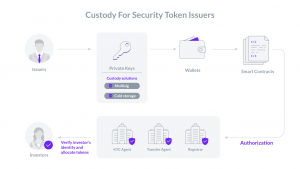One of the key benefits of tokenization is that investors get direct ownership of their assets. Through tokenization, they can directly control their portfolio or delegate the management to third-party service providers. As the assets are controlled by smart contracts, it is important to understand the roles and permissions of each of the parties in order to ensure digital asset custody whilst allowing efficient asset management.
Usually, marketplace platforms enable issuers and investors to manage security tokens across the lifecycle by providing web interfaces reflecting the blockchain states. If the digital asset marketplace helps issuing tokens on a public blockchain, they can also provide ways for their users to connect their blockchain identities and/or wallets to secure the access to smart contracts and token keys. Indeed, issuers and/or their agents need to perform administrative and corporate functions by signing blockchain transactions.
Safekeeping of private keys and authorizing agents
Marketplace operators must not propose wallet services to issuers. Issuers must be in control of their securities as they are the liable counterparty. They can delegate some responsibilities, but they must be able to manage their service providers. Concretely, the issuer must be the technical owners of their smart contracts, and be able to appoint the relevant smart contracts functions to their agents depending on their roles and delegated responsibilities.
Therefore, the issuer needs a wallet that’s set as the owner and controller of the smart contracts and one that can be used to grant certain permissions to its agents. This wallet will therefore not be used on a daily basis and can be easily secured with a multisig or in cold storage.
Everytime a function of a smart contract is triggered, a transaction is sent to the blockchain, and an authorized wallet must sign it. In order to respect the roles and permissions, it is important that each stakeholder manages the access of its own wallet. To reduce risks, these wallets must always be replaceable and this is only possible if the wallets are linked to a blockchain identity. For example, a smart contract owner should be able to change its agent(s) at any time, and the agent should be able to recover the lost tokens of an investor and so on.
Agent roles and marketplaces
Issuers are obligated to perform a range of administrative tasks and functions after the primary issuance of their assets. In traditional markets these functions are typically performed by agents. The marketplace, with its own wallets, can act as an agent and combine different roles such as KYC agent (add proofs of KYC on the blockchain, whitelist Investors, etc.), paying agent, transfer agent, registrar, etc.
These tasks could be performed on the blockchain directly but of course, a web platform triggering the blockchain functions is more suitable and easy to use. Therefore, in order to perform these functions, issuers, or the agent they instruct, should ideally access an administration panel linking the blockchain data with confidential information such as the names and addresses of the Investors.
The marketplace, by leveraging the security token standard they use, should provide a servicing platform in order to manage the lifecycle of the assets. This part of the platform needs to enable the agent or directly the issuer to perform operations on the tokens (like mint/burn, pause/unpause, force transfer, etc.) and to manage investors status and access their identity information. At the minimum, the platform should provide the following set of features:
-
- Asset control and oversight to force and block transfers between their investors.
- Maintain complete and transparent logs of data.
- Run position reports immediately.
- View their cap table that’s automatically updated throughout the lifecycle.
- To perform the recovery process for investors if they have lost their wallet information and access to their security tokens. This can be performed securely through identification of the investor.
We’re looking forward to explaining custody for digital asset investors in the next article. If you can’t wait, this is an excerpt taken from the ebook we published with CoinTelegraph, download here

